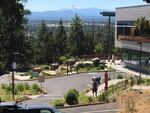As community colleges throughout Oregon continue to deal with the impacts of enrollment declines spurred by the pandemic, the upcoming fall term still feels uncertain. But, in acknowledging the reasons for enrollment drops, some college leaders are seeing strategies that might bring students back.
Central Oregon Community College in Bend endured a roughly 15% drop in enrollment this past fall compared to before the pandemic.
Laurie Chesley, COCC’s president, said there are two big reasons for that.
“The first is that employment is high, which is a key economic factor, and wages in entry-level, unskilled jobs are also fairly high,” Chesley told OPB’s Think Out Loud Wednesday, suggesting many would-be students are working, instead of enrolling in classes.
“The other factor also was COVID.”
Chesley said community colleges throughout the state serve diverse communities, and many students are among the most vulnerable populations at risk for COVID-19.
“They’re already struggling with a lot of different factors — jobs, children, etc. — and then if you add COVID to that mix, it becomes sort of the straw that breaks the camel’s back,” Chesley said. “Furthering your education becomes less of a priority after just surviving through the pandemic.”

FILE--This Aug. 3, 2016, file photo shows the Central Oregon Community College campus with Mount Bachelor on the horizon in Bend, Ore.
Andrew Selsky / AP
Mt. Hood Community College in Gresham also saw fewer students after the pandemic hit. The college experienced a roughly 18% decrease in enrolled students this past fall compared to before the pandemic.
MHCC’s president, Lisa Skari, said the college also lost students who were juggling their lives outside of classes. Some had family obligations such as finding childcare for kids whose school or preschool programs were disrupted.
“But also, paying for college is an expensive endeavor, and so those that were more financially fragile found it more difficult to attend classes and continue in the pandemic, especially with losing employment,” Skari told Think Out Loud.
It’s still a little too early to see what the upcoming fall term, starting in September, will look like, the college leaders said.
Chesley said she expects COCC’s enrollment to stay relatively flat for fall, as it’s been for the past two terms.
“This may be a sign that trends are changing,” Chesley said. “We’ll have to kind of wait and see.”
Still, Skari with Mt. Hood said although students may have chosen to take a break and focus on getting into the workforce and stabilizing their financial situations, community colleges are still crucial to improving career growth.
Although it hasn’t happened during the pandemic, historically community college enrollment has grown during recessions.
“There’s always this opportunity for career growth and future career plans. That’s where the community colleges have always been strong, in providing the skills that employees need for their first job, their second job and throughout their work life.” Skari said. “We still see students coming back for that re-skilling and retooling, for that career advancement and career pathway.”
Community colleges will have a chance to bolster those career pathway offerings thanks to investment from the state. Earlier this year the Oregon Legislature passed the $200 million Future Ready Oregon package focused on workforce development. Roughly $15 million of that will go to the colleges’ career pathway programs.
“This allows each institution to figure out how they’re going to grow and develop the workforce of their community, because that’s ultimately what community colleges are about — supporting our local area,” Skari said.
Chesley said the way that the pandemic forced community colleges to adapt may also bring students back. While online learning started out of necessity as college campuses closed at the start of the pandemic, some students are hoping it sticks around.
“What we’re seeing now a few years into COVID is that we have more students interested in online learning and in various hybrid forms of learning,” Chesley said. “And we feel that that’s a very key strategy for us to improve our enrollments and really to improve access to anybody in our district who wants to come to college.”
While many community colleges have stuck with offering students more online and hybrid courses, public universities on the other hand have pushed to be more fully back in-person, citing the desire for a more traditional on-campus experience.
Chesley said in the 2016-17 academic year about 7,000 students were taking in-person classes while only 200 students were enrolled in online classes. In this current academic year, course modalities were split down the middle — roughly 3,000 students were face-to-face and roughly 3,000 were online.
Both Chesley and Skari said that will likely be a lasting change.
“We’re trying to find this perfect equilibrium in serving our students and being there for those who want to be in person,” Skari said. “But, we know a large contingent of our students need that flexibility that comes with online courses and allows them to work or care for family members. So I see this as how we operate going forward, and finding that perfect balance is I think the challenge in front of us.”
As far as what would be most helpful to the community colleges moving forward, the two presidents point to two things: clarity on the economic forecast for better planning and stronger connections with industries in the state.
“That connection with employers and further honing our offerings of what they need,” Skari said. “... And being responsive to what our communities need in serving students.”
Editor’s note: OPB operates the jazz station KMHD in partnership with Mt. Hood Community College. Lisa Skari is an ex-officio member of OPB’s board.
